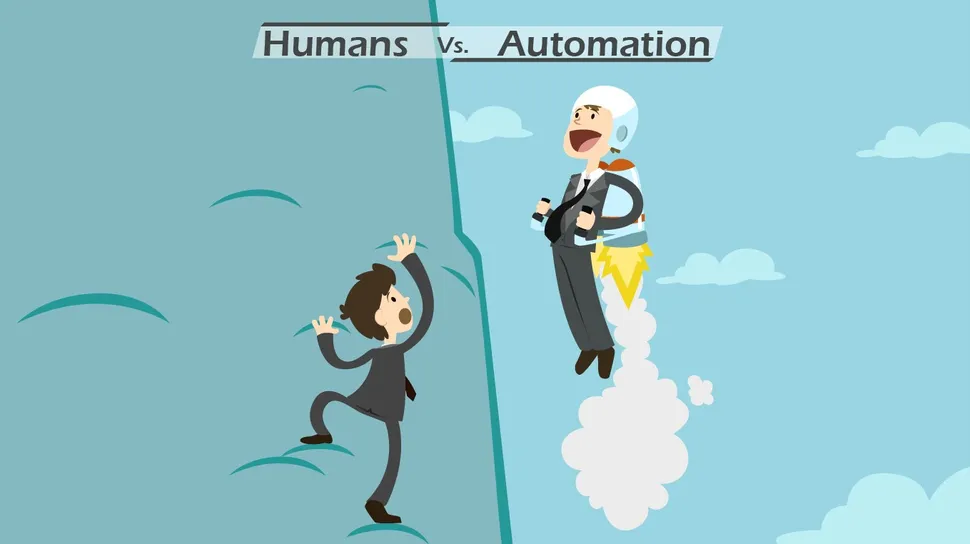How to get the most out of intelligent automation

Getting a digital workforce up-and-running may prove difficult without buy-in
from senior IT personnel, so ensure that their early support is gained. IT
must also be involved from the start to support on many critical fronts, such
as compliance with IT security, building and managing the underlying
infrastructure and accessing target applications. Although digital workers are
trained, governed and run by the business, not getting IT engagement is one of
the fastest ways to curtail an automation program. In fact, working closely
with IT must be an ongoing activity to ensure that the digital workforce
operates optimally with minimal operational issues. For digital worker
campaigns to be sustainable, they must also receive buy-in from senior
executives who will sponsor and champion it. If they see it as a strategic
business project, they’ll help provide the requisite financial and human
resources and help remove any obstacles along the way. It’s important to plan
where digital workers sit within the business so they most effectively scale
as automation demand increases. While an organizational structure provides the
foundation for standard operating procedures, selecting the right design for a
digital workforce program is essential and should be based on key information,
not gut feel.
Diversification and vision drive success in a crisis
What we learned the hard way is that some of our businesses are pretty
dependent on supplies from a single country. For example, we get nearly all
the vitamins for certain animal feed products from India. We knew this, but
when you’re confronted immediately with a complete lockdown in India, you’re
faced with the reality. A border closing is where the biggest risk is. We
quickly started to find other sources to make sure we could continue supplying
customers, and now we’re not dependent anymore on one location for the
majority of our supplies. There were some scary moments that had more to do
with closure of borders, but in the end, I don’t think the supply lines were
that much disrupted. Safety stocks are now being held everywhere in the
organization, which I understand on the one hand, because if I were in
management, I would probably do the same. On the other hand, [doing so] eats
into your liquidity because you’re building up a huge amount of working
capital. We’re now focused on bringing that down again. An unrelated topic is
Brexit, but that also doesn’t help, because in that area we need to prepare
too [for the change in trade regulations]. I think there is a growing
realization that [relying on] 100 percent just-in-time deliveries around the
world might not be the best model.
EU moves closer to encryption ban after Austria, France attacks

The document states: “Law enforcement is increasingly dependent on access to
electronic evidence to effectively fight terrorism, organised crime, child
sexual abuse (particularly its online aspects), as well as a variety of
cyber-enabled crimes. For competent authorities, access to electronic evidence
is not only essential to conduct successful investigations and thereby bring
criminals to justice, but also to protect victims and help ensure security.
“The principle of security through encryption and security despite encryption
must be upheld in its entirety. The European Union continues to support strong
encryption. Encryption is an anchor of confidence in digitisation and in
protection of fundamental rights and should be promoted and developed.
“Protecting the privacy and security of communications through encryption and
at the same time upholding the possibility for competent authorities in the
area of security and criminal justice to lawfully access relevant data for
legitimate, clearly defined purposes in fighting serious and/or organised
crimes and terrorism, including in the digital world, are extremely important.
Any actions taken have to balance these interests carefully.”
Why 90 percent of all machine learning models never make it into production

Companies aren’t bad at collecting data. However, many companies are highly
siloed, which means that each department has its own ways of collecting data,
preferred formats, places where they store it, and security and privacy
preferences. Data scientists, on the other hand, often need data from several
departments. Siloing makes it harder to clean and process that data. Moreover,
many data scientists complain that they can’t even obtain the data they need.
But how should you even start training a model if you don’t have the necessary
data? Siloed company structures — and inaccessible data — might have been
manageable in the past. But in an era where technological transformation is
happening at breakneck speed, companies will need to step up and set up
uniform data structures throughout. ... In addition, engineering isn’t always
deemed essential for data scientists. This is a problem because engineers
might not always understand all the details of what a data scientist
envisions, or might implement things differently due to miscommunication.
Therefore, data scientists who can deploy their models have a competitive edge
over those who can’t, as StackOverflow points out.
What Quantum Computing Could Mean for Software Development

As speculative as quantum software development sounds, it is not an entirely
alien concept. There is a broad class of quantum algorithms, said Yudong Cao,
founder and CTO for startup Zapata Computing, that share similar features as
machine learning models. “If you look at MLOps or AIOps, this is very much the
sort of software engineering challenge [in quantum software] that people also
face with AI.” He leads an effort at Zapata to provide software that might
help industrial players explore possibilities of quantum computing. Cao said
when he started in the field, quantum computing was still largely an academic
discipline with theoretical works that might predict what could be done with a
quantum computer, as well as experimental works that demonstrate what could be
done. “Today we’re seeing this gap become narrower and narrower,” he said. “On
the theory side, we’re improving our algorithms to reduce the amount of
resources. On the other side, new hardware is coming online.” There is a
frontier emerging for quantum computing thanks to software solutions and
hardware maturing, but Cao said the confusing ecosystem needs to be sorted
out. “What is needed is a set of tools that allow people to tap into this
diverse landscape effectively,” he said.
Companies gearing up for 5G era of industry digitisation

For Smart Cities, there will be considerably more ways to manage the community
life in near real-time like enhanced security and mobility, measure pollution,
optimise energy consumption, improve waste management, etc. The list is
virtually endless. Although existing 4G networks have already been
deployed in smart cities around the world, they are limited by the number of
connections they can support, the data they can transmit, and most importantly
the speed they can offer, all of which create hurdles in deployment of smart
cities use cases. 5G is expected to overcome these hurdles, and allow large
number of connections, providing super-high bandwidth, and ultra-low latency
based communications, to build a connected city – a smarter city. 5G will
provide the infrastructure to roll out these innovations that appear promising
today. Therefore, 5G opens up a whole world of new possibilities. Until the
fourth generation network (4G), consumers were the first to benefit from each
new generation of wireless technology. However, the main interest of 5G lies
in business-to-business markets. This next generation of mobile
telecommunications will become the backbone of industrial operations in the
broadest sense.
When It Comes to Culture, Does Your Company Walk the Talk?

To address whether stated values shape employee behavior, we first measured
what companies say they value. The simplest way to quantify corporate culture
would be to treat each value as binary — a company either listed it as a core
value or did not. When Charles Schwab lists innovation as one of four core
values, it is presumably more focused on it than Quicken Loans, which includes
innovation among a laundry list of 19 elements of its culture. To quantify
each company’s relative focus on a value, we weighted it by the inverse of the
total number of values listed. So innovation was weighted at 25% for
Charles Schwab and 5% for Quicken Loans. (A company that didn’t list a
specific value received a weighting of zero for that value.) To control for
differences across sectors, we assigned each company to one of 33
industries. We then ranked each company in its industry based on the
weighting for each value we measured. To assess how well companies live up to
their stated values, we used data from the 2019 Culture 500, which ranks
companies on nine of the most commonly cited values. Every Culture 500 company
received a sentiment score that measured how positively employees talked about
a specific value in the free text of their Glassdoor reviews.
10 ways the pandemic affected cloud investment

One initiative that emerged as being one of the most important for the
enterprise was remote resiliency, which was put to the ultimate test in March,
when the organizations that had the ability to go remote, did. The pressure
was on for IT departments who had to rally to be sure telecommuters had access
to the company online, that their personal devices were safe, and keep
vigilant watch, as hackers took advantage of the COVID-19 crisis' imposed
mobilization of the industry. As coronavirus cases and the resultant deaths
rise, the burden of investing in the cloud grows exponentially. A new report
from SPR, "Cloud Investment in the Age of Accelerated Evolution" offers
research culled from an investigation into the state of enterprise cloud
adoption, in what it calls "this uniquely transformative moment." The
report cites 10 key findings, which include a reveal of the biggest barrier to
effective cloud security: The organization's budget. But in the next 12
months, 41% of IT decision-makers said they plan to increase security budgets.
The engagement with the cloud had been enthusiastic, but COVID-19 sent the
innovations into fast forward, which meant that the enterprise was able to
assess use quicker, but since it was a digital transformation that evolved
from urgent need rather than careful observation and experience, it's now time
to make the cloud more efficient.
Stargate: A new way to think about databases

DataStax is getting there by open sourcing the Cassandra coordinator code.
DataStax started with Cassandra for obvious reasons: The company knows the
database well and Cassandra is a great option for handling distributed data
requests. But it’s that coordinator code that is the heart of Stargate, as
Gosnell explained. The hardest aspect of the logic between a customer’s API
and their back end is the distributed request coordination, i.e., ensuring
proper load balancing, directing database requests to the right place, etc.
This is what Cassandra’s coordinator code does well. The company wants more
developers to “join our community and help us prioritize which features we
need next” in Stargate, Gosnell stressed. It’s a great story, one that helps
DataStax, of course, but also has the potential to be useful for other vendors
and with other databases. And that is where Stargate could go from an
interesting, single-vendor project into something much more noteworthy.
Consider Kubernetes, for example. It was cool technology when its Borg
ancestor ran exclusively within Google, and it remained cool as an open source
project to which Google employees, almost exclusively, contributed.
Where Does Data Governance Fit into a Data Strategy

The data of the organization is a valuable tool to enable improvements in
product development, customer interaction and satisfaction, quality improvement
and impacts the organization’s bottom line in terms of decision-making, and
improvements in quality, efficiency and effectiveness. Everybody, at all levels,
must recognize that your organization’s data governance program will enable you
to strategically manage data as an asset to achieve accurate, trusted, and
secure data that delivers business intelligence focused on leveraging and
building a competitive advantage. The impact on the data of the organization
will be significant. Employees and partners will benefit from everything stated
as the purpose of the data governance program (in the previous answer). The
impact on individuals roles will depend on people’s present relationship to the
data, however, the intent at your organization is to take a less pervasive
approach that aims to minimize disruption to normal business activities.
Individuals that define data will become educated on the aspects of data
definition that drive improvements to the organization’s confidence in the data
they use. Individuals that produce data will become educated in quality data
production including timeliness, accuracy, completeness and relevance.
Quote for the day:
"A real friend is one who walks in when the rest of the world walks out." -- Walter Winchell
No comments:
Post a Comment